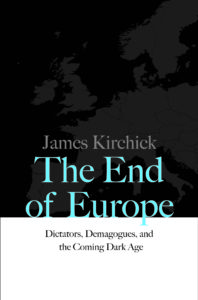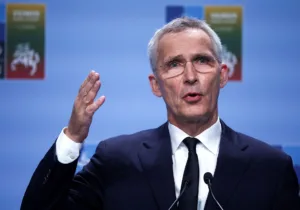“By the skin of our teeth” was how celebrated art historian Kenneth Clark described the grotesquely improbable revival of Western civilization after the fall of the Western Roman Empire. In the opening of his landmark and definitive art history documentary Civilisation (1969), Clark emphasized how European civilization nearly vanished in the Dark Ages (500-1000): “Looking at those great works of Western man and remembering all that he has achieved in philosophy, poetry, science, lawmaking, it does seem hard to believe that European civilization could ever vanish, and yet you know it has happened once…when the barbarians ran over the Roman Empire. For two centuries, the heart of European civilization almost stopped beating.” Yet under Charlemagne the theological, political, and artistic consciousness of “Western man” ultimately escaped extinction “by the skin of our teeth.” Clark’s meditation on the fragility of the Western order is reflected in a more recent assertion that European civilization, once again, may soon be lost: James Kirchick’s The End of Europe: Dictators, Demagogues, and the Coming Dark Age.
Kirchick, a Daily Beast correspondent, wrote End of Europe after more than six years inhabiting and reporting on Europe. The book provides eight case chapters—seven nations plus the European Union as a whole—which indicate that postwar Europe, for several very different reasons, has suddenly become dangerously unmoored from its central ethos of liberal democratic politics. “As the memory of World War II, the Holocaust, and the gulag fades,” he writes in his concluding chapter, “so too does antipathy to the illiberal ideologies that spawned Europe’s past horrors” (225).
Kirchick’s strongest narratives concern renewed authoritarianism in Russia and European irresolution in the face of Putin’s constant subversion and occasional violence. The first chapter includes his “Russophobic” analysis, followed by review of sympathetic nativist nationalism in Hungary under Viktor Orbán in the second and then Ukraine in the eighth. End of Europe hails the 2013-14 Maidan street resistance against Ukraine’s then pro-Kremlin president Viktor Yanukovych as the ideological heir to the various interrupted “color” revolutions of the previous decade. However, Kirchick argues not only that Russian subversion of Ukraine has been belittled and insufficiently emphasized in the West, but that it constitutes “the starkest threat to world order since Saddam Hussein’s 1990 invasion and annexation of Kuwait” (218).
 The renewed Russian threat looms large throughout End of Europe, and his reading of Putin’s foreign relations echoes the early Cold War realism of George Kennan, who helped create containment policy in response to the Soviet Union. “Russia,” Kirchick writes, “is illiberal, authoritarian, nationalistic, Orthodox Christian, and economically autarkic, a compilation of reactionary values distilled into an ideology known as ‘Eurasianism’, the new doctrine of Russian imperialism” (21). The Obama administration’s infamous “reset” with Moscow is rightly condemned (24), and amid the persistent though indefinite concern that the Kremlin may have somehow helped bring President Trump to power or otherwise exerts some leverage over him, Kirchick’s glimpses into Russian cyberwar upon the West (27, 75, 218) come at a very opportune time.
The renewed Russian threat looms large throughout End of Europe, and his reading of Putin’s foreign relations echoes the early Cold War realism of George Kennan, who helped create containment policy in response to the Soviet Union. “Russia,” Kirchick writes, “is illiberal, authoritarian, nationalistic, Orthodox Christian, and economically autarkic, a compilation of reactionary values distilled into an ideology known as ‘Eurasianism’, the new doctrine of Russian imperialism” (21). The Obama administration’s infamous “reset” with Moscow is rightly condemned (24), and amid the persistent though indefinite concern that the Kremlin may have somehow helped bring President Trump to power or otherwise exerts some leverage over him, Kirchick’s glimpses into Russian cyberwar upon the West (27, 75, 218) come at a very opportune time.
End of Europe’s remaining chapters are difficult to characterize. The most distinctive is “France without Jews,” which documents what appears to be an appalling increase in anti-Semitic violence in France principally on account of a synthesis of Muslim immigration and Leftist denialism, and the inability or unwillingness of the authorities to respond. In 2011, for example, 1,900 French Jews emigrated to Israel, yet 8,000 did so in 2015 (143), as a response to a social climate of intimidation and violence emanating from “no go” (non-droit) Islamic neighborhoods unconnected with the surrounding population.
This general narrative corresponds to the fourth chapter’s concerns with the migration crisis, in which Kirchick reveals sufficient realism to perceive, and honesty to confront, the nearly impossible task of rapidly absorbing and effectively assimilating so many Muslim migrants of a completely different cultural background from European secularism. “Fourteen hundred sexually abused children in Rotherham, 1,200 sexually assaulted women across Germany, vast Muslim ghettoes dotting the continent” are for Kirchick the “consequences of Europe’s moral equivalence, cultural self-abnegation, and outright cowardice on the question of Islam” (128).
Meanwhile, he imputes the misery of Greece (ch. 7) primarily to its own political corruption, disorderly conduct, and foolish insouciance, whilst Brexit (ch. 6) derived from the repeated mistakes of Labour on immigration policy. The German case chapter, finally, appears to suggest that the Federal Republic remains a theatre of contestation between Washington and Moscow, and that German Socialism dangerously and hypocritically inclines toward the latter.
End of Europe provides an informative tour through contemporary political developments across cases, and is thus highly recommended for policymakers, business travelers, and other lay participants seeking a brief but applicable overview. When read alongside Douglas Murray’s more focused Strange Death of Europe: Immigration, Identity, Islam, also in print this year, the evidence seems to mount that the reformulation of a “containment” policy—formerly aimed at global Communism—may perhaps become necessary with respect to global Islam, or at least to some version of it.
Be that as it may, the lack of analytical rigor in Kirchick’s volume is remarkable. It advances no discernible thesis, the reader is never told the reason his cases are selected, and Italy, Switzerland, Spain, Portugal, the former Yugoslavia, and much of the former Iron Curtain are completely ignored in a treatise purportedly concerned with their “end.” Neither is there any discussion at all of policymaking at the European level, such that one almost forgets that the European Parliament, Court, Commission, Central Bank, Council of Ministers, and a whole spectrum of executive agencies even exist. But if European civilization is truly at an end and will not escape by the skin of its teeth, then ought we to dwell on the minor deficiencies of literary execution?
—
Mark R. Royce, Ph.D., teaches political science at George Mason University and NVCC Annandale and is author of the forthcoming Political Theology of European Integration: Comparing the Influence of Religious Histories on European Policies, which probes the religious ideas behind EU politics. He has written for The European Legacy, International & Comparative Law Quarterly, and the Journal of Church & State.
Photo Credit: RobinTphoto, via Flickr.






 Sponsor a student for Christianity & National Security 2024
Sponsor a student for Christianity & National Security 2024